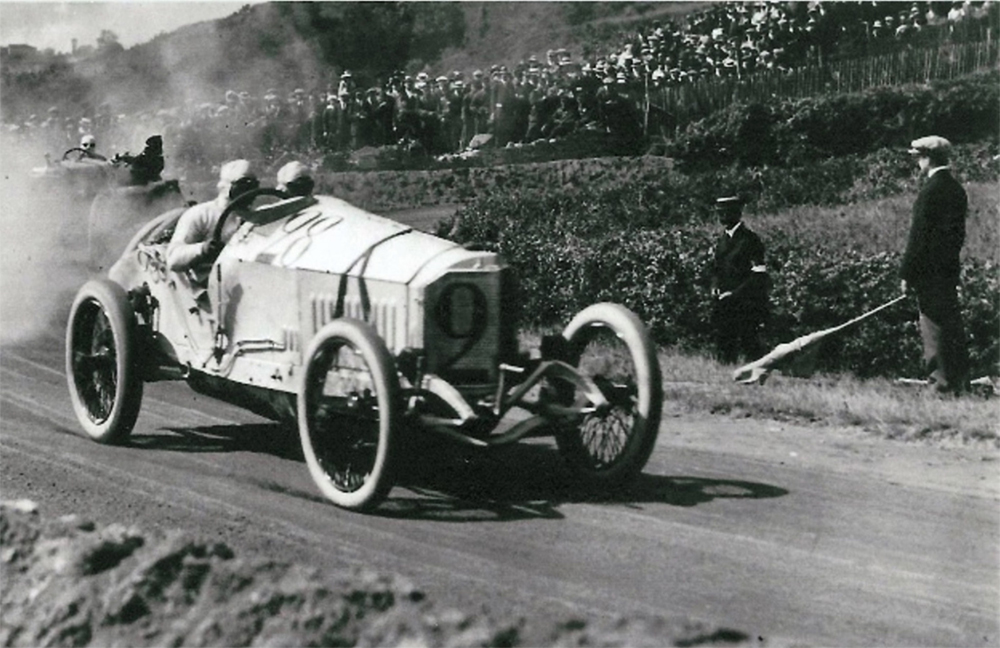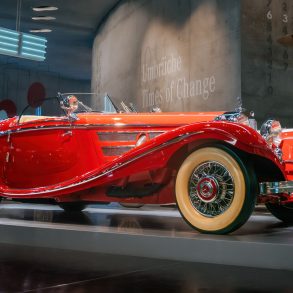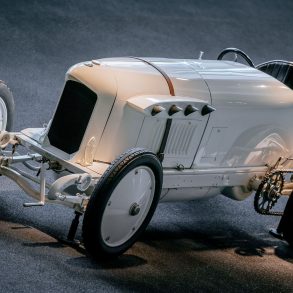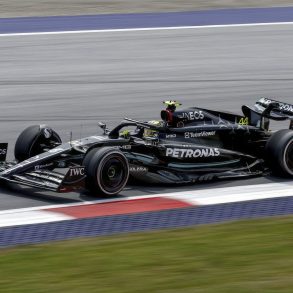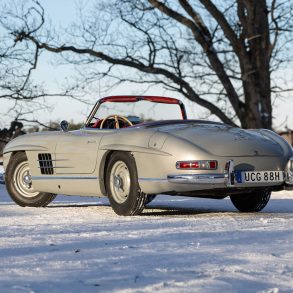Mercedes 1914 GP
Car: Mercedes 18/100 / Engine: Water-Cooled, M93654, Inline-4 / Maker: Mercedes / Bore X Stroke: 93 mm X 165 mm / Year: 1914 / Capacity: 4483 cc / 273.6 in³ / Class: Grand Prix / Power: 85.8 kw / 115.1 bhp @ 3200 rpm / Wheelbase: 2845 mm / 112.0 inches / Track: 1330 mm / 52.4 in Front; 1350 mm / 53.1 in Rear / Weight: 1080 kg / 2381 lbs / Tires: Front Tires: 815×120 mm; Rear Tires: 920×135 mm
In Mercedes’ absence, Peugeot had come to the fore with hugely sophisticated twin-cam, four valve per cylinder Ernest Henry designed engines and four-wheel brakes. These cutting edge machines had taken victories in the 1912 and 1913 French Grands Prix and seeing the acclaim that their racing success brought Peugeot, Mercedes decided to contest the new formula in 1914.
Leaving little to chance, Mercedes built an experimental six-cylinder engined cars for the 1913 Grand Prix de la Sarthe in the form of an Opel. Considering the new-for-1914 displacement limit of 4.5 litre and maximum weight of 1100 kg, Mercedes figured a four cylinder engine but one running at a higher rpm, with up to 3,500 rpm being contemplated. The race had all the making of a titanic battle.
Like Fiat before them Mercedes utilized aero-engine technology in the development of their engine and a brand new straight four was developed. It was built on an aluminum crankcase with separate steel cylinders. Welded on the cylinders, the individual heads sported four valves. Rather than using a double over-head camshaft Mercedes depended on single overhead camshaft to actuate the valves. Designed to run at twice the speed of any Mercedes engine that had come before, lubrication of the new ‘four’ was vital. An intricate system was fitted that combined a wet sump with a high pressure pump. No piston rings were fitted so, by the design, the engine used oil. Additional oil could be fed into the system by a manual pump, to be operated by the riding mechanic. To prevent the plugs from fouling, up to four plugs could be fitted, although the cars raced with three. With an eye on reliability these were powered by two separate magnetos. The engine was built by the car section of the factory but tested by the aero-engine staff.
The chassis followed convention with a cross-braced, pressed-steel frame suspended by semi-elliptic leaf springs and solid axles. One of the things carried over from the 1913 experimental cars was the V-shaped radiator and tightly wrapped aluminum body complete with belly pan.
The sweetest music I have ever heard is the song from this engine, reminisced Christian Lautenschlager.
Touted as the most important race yet, the entrants of the French Grand Prix not only represented the respective manufacturers but also their countries of origin. Considering the political tension that was quickly building around Europe, the nationalistic feelings reached boiling points.
Mercedes had two of the new cars ready in time to be sent among other Mercedes cars to Lyon-Givors for testing in April before the track was closed for competition. Some have said that the Peugeot team were the victims of over confidence, being unbeatable the year before they may though it would have been enough just to show up for that is basically what they did. Only just returning from their triumph at Indianapolis the team had time to take part in a meager practice period that was allowed at the last moment and only due to the French teams late arrival. Mercedes entered five cars and in addition to three Peugeots. Other entries were fielded by Fiat, Opel and Sunbeam. Among the Mercedes drivers was the company’s dependable test pilot Christian Lautenschlager, who had won the 1908 Grand Prix for Mercedes. The French team’s honor would in the main be defended by their dashing driver Georges Boillot. It was as if the ire drivers very different personalities defined each nations approach.
Max Sailor, a Mercedes director and race car driver led from the start with the Peugeot of Georges Boillot in second. The leading Mercedes developed engine trouble and on the sixth lap the Peugeot took the lead. The French crowd erupted into patriotic demonstrations. The order was now Peugeot, the Mercedes of Lautenschlager, another Peugeot and the Mercedes of Wagner. It was now Wagner’s turn to make a charge and on the 11th lap he forced his way into second.
The second Peugeot, driven by Goux began to overheat and was destined to retire. This left the Peugeot of Boillot still ahead of the on coming Germans. The 15th lap had now been completed with the Peugeot 2 minutes and 28 seconds ahead of the Mercedes driven by Wagner. After running a conservative race in the early laps Lautenschlager was now poised to begin his march. Passing his teammate he began to close the gap on the leading Peugeot. Boillot drove for all he was worth but nothing could stop the Mercedes from taking the lead. The Peugeot, not able to withstand the strain broke a valve and retired, it’s gallant driver collapsing over the steering wheel. Mercedes now owned the first three places and so they finished with Lautenschlager claiming his second ACF Grand Prix title. The sullen crowd responded with only a smattering of applause while the Mercedes pits erupted in joy.
Shortly after the French Grand Prix, War spread across the continent and all racing was suspended. One of the cars had been rushed out of the country for Ralph DePalma to race in the United States. He won several races, including the 1915 Indy 500. Pressed for money, Mercedes sold several of the other Grand Prix racers to privateers after the War.






